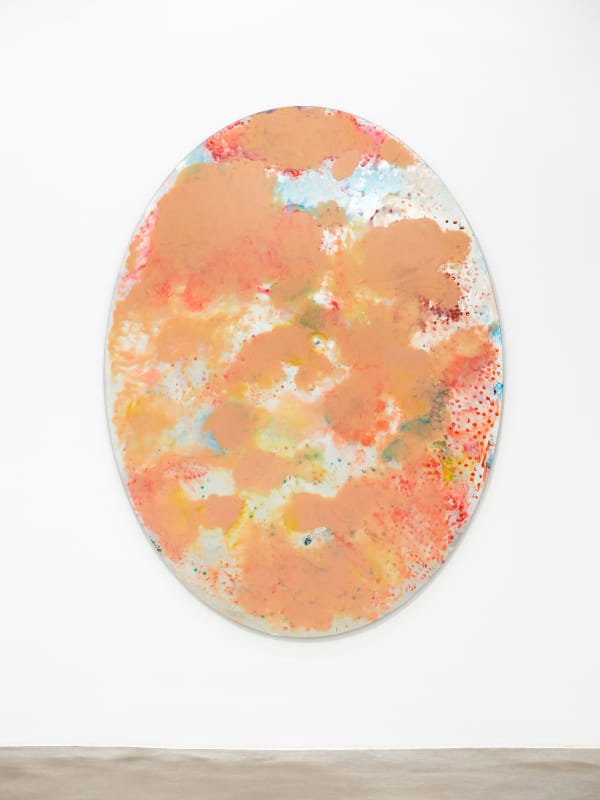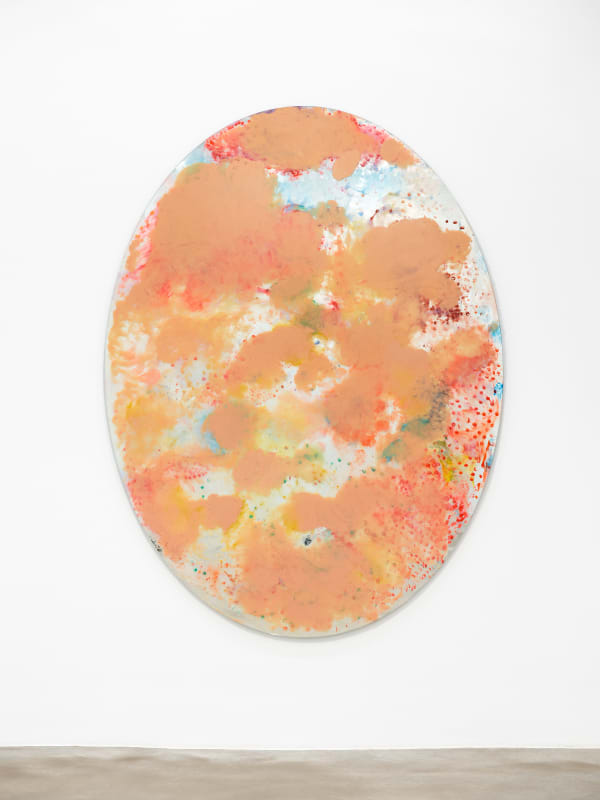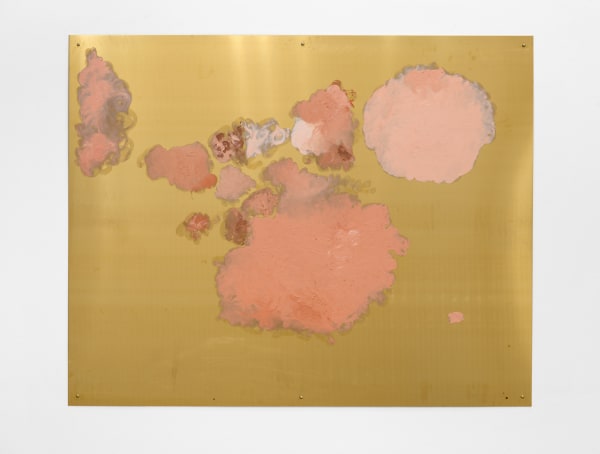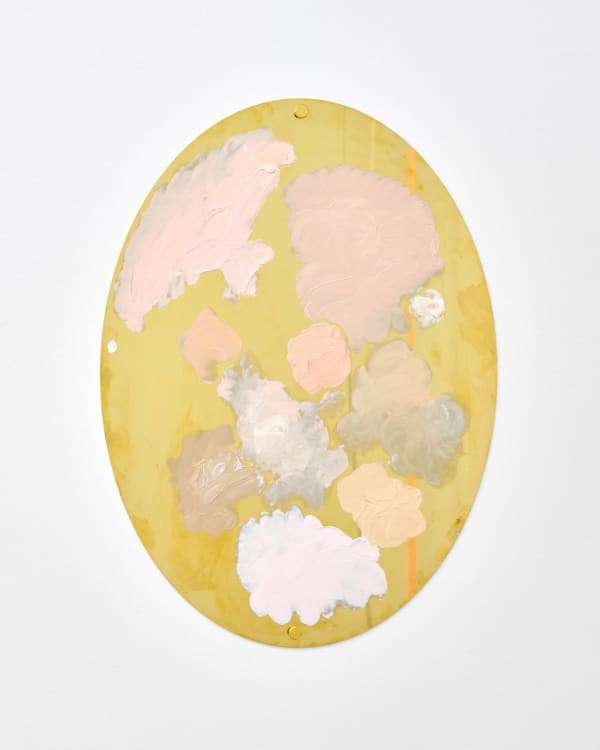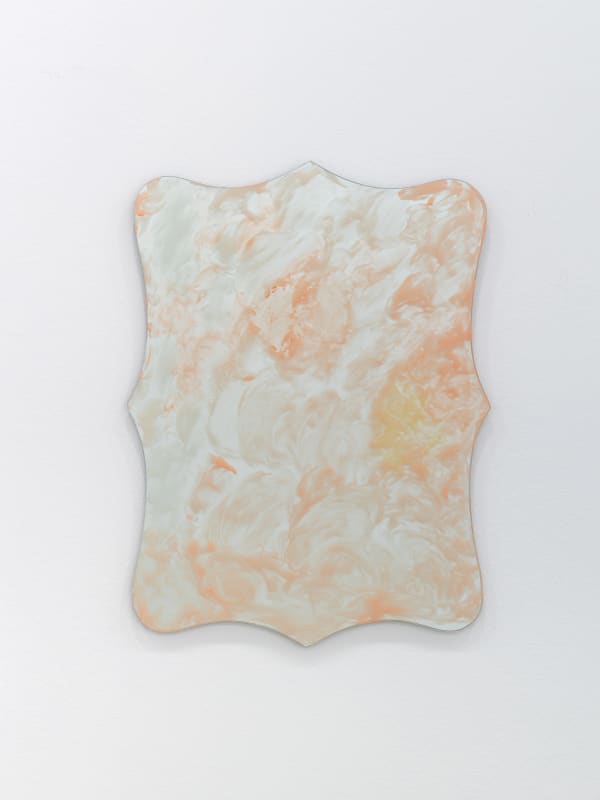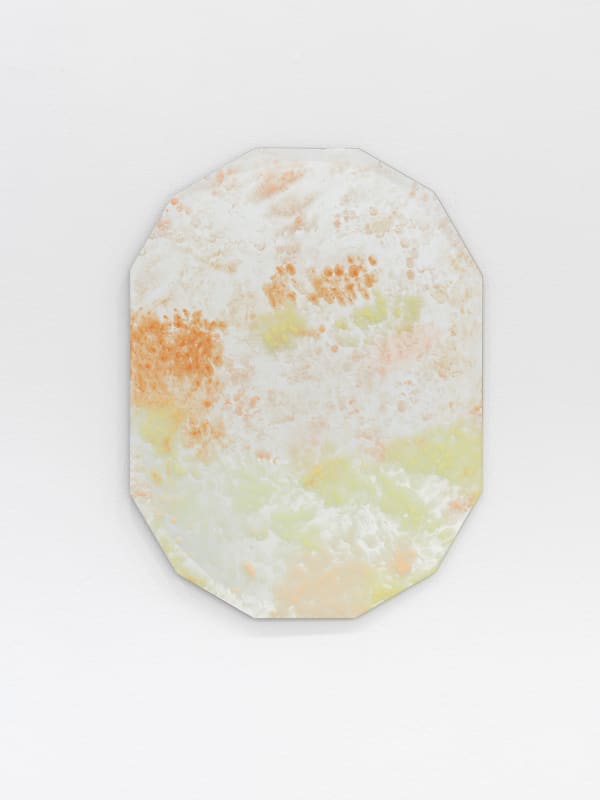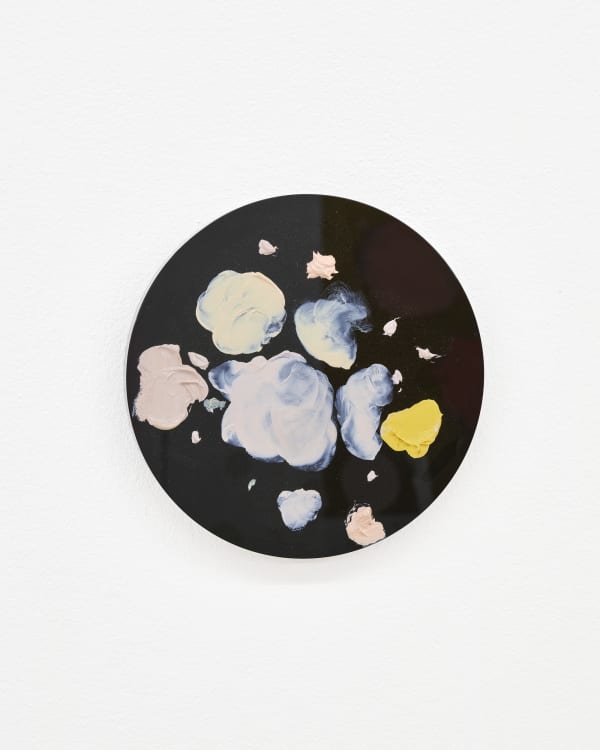Karla Black: Karla Black
Opening
Thursday 02.10 at 5 – 7 PM
“All artists, if they are to survive, are forced, at last, to tell the whole story, to vomit the anguish up.”
The words of author, poet, activist, and playwright James Baldwin come to mind as I listen to Karla Black trying to explain her work, her process, why she does what she does, what she thinks about her own art and about art in general. She is giving a lecture on her own artistry, and it appears she struggles somewhat with the very act of explaining her art, as well as with finding the right words and expressions to convey her meaning to the audience.
She is giving the lecture I am watching some years after representing her native Scotland at the Venice Biennale and being nominated for the prestigious Turner Prize. She has been invited to speak ahead of an upcoming major exhibition of her work at a prominent institution, where she has also been asked to select pieces from the institution's permanent collection—including a Helen Frankenthaler, a Morris Louis, and a Carolee Schneemann. She has chosen abstract expressionists and colour field painters because these are the artists she feels closest to when she creates, even though her own work results in sculptures and installations rather than paintings. She says she paints her sculptures, and colour itself is also of utmost importance and weight.
Weight, as in weightless, because the non-weight of colour is fundamental; Black works exclusively with light hues: almost-blue and almost-pink; she uses almost-materials and creates almost-forms.
At this year's edition of the Danish literature festival Louisiana Literature, American multi-artist Laurie Anderson performed alongside French star author Édouard Louis. The theme focused on escape—what it is, whether it is possible to truly escape, and what one encounters when doing so. Anderson sees escape not only as a physical act but also as a philosophical idea of breaking free from labels, expectations, and panic through imagination, learning, and empathy. She argues that imagination is more than just distraction; it is a powerful tool for freedom and a way to gain a deeper understanding of the world and others.
Art is escape and freedom, says Karla Black, unconsciously echoing Anderson. Art is a way of expressing our instinctual behaviours, she believes–a raw, animalistic moment that is not allowed to exist in many other ways than in the very moment of creation. American land art artist Robert Smithson once said that ‘A work of art when placed in a gallery loses its charge, and becomes a portable object or surface disengaged from the outside world’. Black agrees, even though she knows she is dependent on galleries and institutions. “I have chosen to be able to have a life,” she has expressed, pointing to the fact that she chooses to exhibit even though the art then is not fully allowed to remain in flight, in freedom, in the animalistic moment. This is also where the reluctance to explain her work comes in. “People ask: what is the meaning of this sculpture?”, she states in an interview. “I don’t understand that question and I’m not remotely interested. Rather than having a meaning it has a function. Rather than having an ephemeral relationship to language outside of itself, I’d rather ask: what are the consequences of this sculpture, how does it function in the world, how does it operate, what does it do?”
As for the colours and what they do, they add, among other things, appeal and help prevent misleading interpretations. The hues that Black uses must be soft pastels to evoke attraction rather than thoughts of decay or decomposition, which they could easily suggest given that the materials she chooses range from glass, paint, plaster, and textiles to toilet paper, makeup, and nail polish. She herself sees no difference between the materials and firmly refuses to value them according to any kind of hierarchy. Such a ranking, Black believes, is only a pretense, because all materials are made of the same thing. Plaster comes from the ground, pigments come from the ground – whether used in eyeshadow or artists' paints, they are all natural materials. And since we are all animals, everything we create is, in a sense, natural.
She also views materials as a form of communication that language can never replicate. Black believes that language is an inadequate, even inappropriate, tool for communication, and prioritizes material experience over linguistic experience to understand and navigate the world.
It brings me to the words of American author and critic Hilton Als, who, after seeing a performance by the aforementioned James Baldwin, writes that he doesn’t want to talk about the performance too much, but he has been asked to, and in order to survive in the culture of explanation, he must explain. ‘But how do you explain the heart?’ he asks rhetorically, and, like Black, defends himself against the limitations of language. ‘A sensibility? Love?’
Black's heart appears to be entirely rooted in art, and perhaps it can also be explained through it, but without words, because she wants the materials to speak for themselves.
Robert Smithson believed that language is a material, and by using text in his artworks, he sought to demonstrate how language itself is a form of structure that can be experienced visually, much like a sculpture or a landscape. Following psychoanalyst Melanie Klein, Black also discusses ‘pre-speech’ and ‘beyond speech’: the concept that we are familiar with materials, colours, and shapes long before we learn the words for them. Individuals develop their psyche through their relationships with ‘objects’, meaning other people and experiences. Klein believes that children's relationships with the objects in their environment shape how they understand and interact with the world, and for Black, her childhood relationship with materials has never gone away. She has stated that she understands she was once much closer to the earth than she is now, but she cannot understand how that perspective can go away in other people. She describes her work as a kind of digging in the earth, and the pain it would cause her to disconnect from the physical world.
The exhibition at Belenius is titled Karla Black, as are all other exhibitions featuring the artist. This is symptomatic, of course, because we now know that her exhibitions are not about searching for meaning, but about the consequences of the works in the room. Her works often dominate the rooms entirely, covering them in pink powder sand dunes, mounds of earth speckled with gold leaf, and large ethereal formations in pastel-like almost-colours. She approaches the gallery space in the same paradoxical way that she herself describes her art: she dislikes being part of the art market, yet the white cube of the gallery space is her most interesting place – not in terms of connotations or research, but because of its physical reality, of what it is. At Belenius, too, material hierarchies are broken down, with fragile sculptural works in mirror glass contrasting against even more delicate toilet paper installations, soft lip gloss playing with soft Vaseline, and colour pigments taken from eyeshadow and Lush bath bombs.
What are the consequences of the works in the gallery space at Belenius? ‘History is an angel blown backwards into the future,’ said Laurie Anderson at Louisiana, and Black blows her postmodernist colleagues into the room as she paints her works, like Frankenthaler, like Louis, like Pollock. Attractiveness is central, and even though she follows the development of media in postmodernism, she also tenderly embraces aesthetics, gesture, and their role in art history.
“I want you to understand how much I really love art,” says Black in her lecture in her soft Scottish accent, pouring out her love for Frankenthaler, Eva Hesse, and Schneemann.
And perhaps that is where we must leave it. Too much has already been written about art that simply seeks to be free. The only way to even attempt to explain Karla Black’s work might be to follow Hilton Als’s example, as he struggles, yet tries, to explain the heart.
How does one explain Karla Black's art?
A sensibility?
Love?
– Karolina Modig, 2025
Karla Black (b. 1972) in Alexandria, UK. Lives and works in Glasgow, UK.
Black's abstract and immersive sculptures are created through her experimentation with unconventional materials. These monumental yet ephemeral and seemingly weightless chalked paper works continue Black’s investigation of materiality and texture, and the emotions they transmit.
Her interplay of delicate abstract forms, pastel colors and surprising materials demands a physical experience and encourages a new way of not only seeing but also perceiving. Material experiences is Black’s preferred way to understand the world and communicate within it. For her, materiality is closely tied to psychological states of being.
Black has had institutional solo exhibitions at Kunstraum Dornbirn, 2025, Bechtler Stiftung, Uster 2024, The New Art Gallery Walsall, 2023, Fruitmarket Gallery, Edinburgh 2021, Des Moines Art Centre 2020, The Power Plant, Toronto 2018, Museum Dhondt-Dhaenens, Deurle 2017, Scottish National Galleries of Modern Art, Edinburgh 2016, Irish Museum of Modern Art, Dublin 2015, Kestnergesellschaft, Hannover 2013, Dallas Museum of Art, Gallery of Modern Art, Glasgow, both 2011, among others.
In 2011 she was nominated for the Turner Prize and represented Scotland at the 54th Venice Biennale.
Black's work is part of major contemporary collections such as the Hammer Museum, Los Angeles, Migros Museum für Gegenwartskunst, Zurich, Scottish National Gallery of Modern Art, Edinburgh, Solomon R. Guggenheim Museum, New York and Tate Gallery, London.
– Capitain Petzel and Galerie Gisela Capitain
Artwork photo by Simon Vogel and Viktor Sjödin.
Courtesy of the artist and Galerie Gisela Capitain.
